Chemical industry
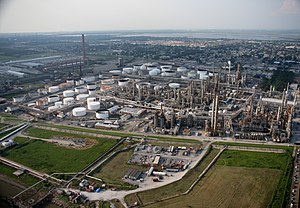
The chemical industry comprises the
Various professionals are involved in the chemical industry including chemical engineers, chemists and lab technicians.
History
Although chemicals were made and used throughout history, the birth of the heavy chemical industry (production of chemicals in large quantities for a variety of uses) coincided with the beginnings of the Industrial Revolution.
Industrial Revolution
One of the first chemicals to be produced in large amounts through industrial processes was sulfuric acid. In 1736 pharmacist Joshua Ward developed a process for its production that involved heating sulfur with saltpeter, allowing the sulfur to oxidize and combine with water. It was the first practical production of sulphuric acid on a large scale. John Roebuck and Samuel Garbett were the first to establish a large-scale factory in Prestonpans, Scotland, in 1749, which used leaden condensing chambers for the manufacture of sulfuric acid.[1][2]
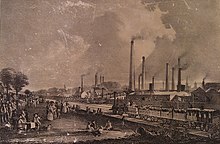
In the early 18th century, cloth was bleached by treating it with stale
In Britain, the Leblanc process became popular.[5] William Losh built the first soda works in Britain at the Losh, Wilson and Bell works on the River Tyne in 1816, but it remained on a small scale due to large tariffs on salt production until 1824. When these tariffs were repealed, the British soda industry was able to rapidly expand. James Muspratt's chemical works in Liverpool and Charles Tennant's complex near Glasgow became the largest chemical production centres anywhere. By the 1870s, the British soda output of 200,000 tons annually exceeded that of all other nations in the world combined.
These huge factories began to produce a greater diversity of chemicals as the Industrial Revolution matured. Originally, large quantities of alkaline waste were vented into the environment from the production of soda, provoking one of the first pieces of environmental legislation to be passed in 1863. This provided for close inspection of the factories and imposed heavy fines on those exceeding the limits on pollution. Methods were devised to make useful byproducts from the alkali.
The
The manufacture of chemical products from
were later added to the product line.Expansion and maturation
The late 19th century saw an explosion in both the quantity of production and the variety of chemicals that were manufactured. Large chemical industries arose in Germany and later in the United States.
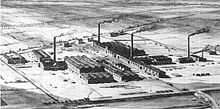
Production of artificial manufactured
The
By the 1920s, chemical firms consolidated into large conglomerates; IG Farben in Germany, Rhône-Poulenc in France and Imperial Chemical Industries in Britain. Dupont became a major chemicals firm in the early 20th century in America.
Products
Polymers and plastics such as polyethylene, polypropylene, polyvinyl chloride, polyethylene terephthalate, polystyrene and polycarbonate comprise about 80% of the industry's output worldwide.[11] Chemicals are used in many different consumer goods, and are also used in many different sectors. This includes agriculture manufacturing, construction, and service industries.[11] Major industrial customers include rubber and plastic products, textiles, apparel, petroleum refining, pulp and paper, and primary metals. Chemicals are nearly a $5 trillion global enterprise, and the EU and U.S. chemical companies are the world's largest producers.[12]
Sales of the chemical business can be divided into a few broad categories, including basic chemicals (about 35% - 37% of dollar output), life sciences (30%), specialty chemicals (20% - 25%) and consumer products (about 10%).[13]
Overview
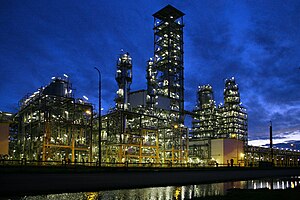
Basic chemicals, or "commodity chemicals" are a broad chemical category including polymers, bulk petrochemicals and intermediates, other derivatives and basic industrials, inorganic chemicals, and fertilizers.
Polymers are the largest revenue segment and includes all categories of plastics and human-made fibers. The major markets for plastics are packaging, followed by home construction, containers, appliances, pipe, transportation, toys, and games.
- The largest-volume polymer product, polyethylene (PE), is used mainly in packaging films and other markets such as milk bottles, containers, and pipe.
- Polyvinyl chloride (PVC), another large-volume product, is principally used to make piping for construction markets as well as siding and, to a much smaller extent, transportation and packaging materials.
- Polypropylene (PP), similar in volume to PVC, is used in markets ranging from packaging, appliances, and containers to clothing and carpeting.
- Polystyrene (PS), another large-volume plastic, is used principally for appliances and packaging as well as toys and recreation.
- The leading human-made fibers include polyester, nylon, polypropylene, and acrylics, with applications including apparel, home furnishings, and other industrial and consumer use.
Principal raw materials for polymers are bulk petrochemicals like ethylene, propylene and benzene.
Other derivatives and basic industrials include synthetic rubber, surfactants, dyes and pigments, turpentine, resins, carbon black, explosives, and rubber products and contribute about 20 percent of the basic chemicals' external sales.
chemicals.
Life sciences
Life sciences (about 30% of the dollar output of the chemistry business) include differentiated chemical and biological substances,
Specialty chemicals
Consumer products
Consumer products include direct product sales of chemicals such as soaps, detergents, and cosmetics. Typical growth rates are 0.8 to 1.0 times GDP. [citation needed]
Consumers rarely come into contact with basic chemicals. Polymers and specialty chemicals are materials that they encounter everywhere daily. Examples are plastics, cleaning materials, cosmetics, paints & coatings, electronics, automobiles and the materials used in home construction.
Annually the American Chemistry Council tabulates the US production volume of the top 100 chemicals. In 2000, the aggregate production volume of the top 100 chemicals totaled 502 million tons, up from 397 million tons in 1990. Inorganic chemicals tend to be the largest volume but much smaller in dollar revenue due to their low prices. The top 11 of the 100 chemicals in 2000 were sulfuric acid (44 million tons), nitrogen (34), ethylene (28), oxygen (27), lime (22), ammonia (17), propylene (16), polyethylene (15), chlorine (13), phosphoric acid (13) and diammonium phosphates (12).[citation needed]
Companies
The largest chemical producers today are global companies with international operations and plants in numerous countries. Below is a list of the top 25 chemical companies by chemical sales in 2015. (Note: Chemical sales represent only a portion of total sales for some companies.)
Top chemical companies by chemical sales in 2015.[16]
Technology

From the perspective of chemical engineers, the chemical industry involves the use of chemical processes such as chemical reactions and refining methods to produce a wide variety of solid, liquid, and gaseous materials. Most of these products serve to manufacture other items, although a smaller number go directly to consumers. Solvents, pesticides, lye, washing soda, and portland cement provide a few examples of products used by consumers.
The industry includes manufacturers of
| Product Type | Examples |
|---|---|
inorganic industrial
|
ammonia, chlorine, sodium hydroxide, sulfuric acid, nitric acid |
| organic industrial | acrylonitrile, phenol, ethylene oxide, urea |
| ceramic products | silica brick, frit
|
| petrochemicals | ethylene, propylene, benzene, styrene |
| agrochemicals | herbicides
|
| polymers | polyethylene, Bakelite, polyester |
| elastomers | polyisoprene, neoprene, polyurethane |
oleochemicals
|
lard, soybean oil, stearic acid |
explosives
|
nitroglycerin, ammonium nitrate, nitrocellulose |
fragrances and flavors
|
benzyl benzoate, coumarin, vanillin |
industrial gases
|
nitrogen, oxygen, acetylene, nitrous oxide |
Related industries include
Chemical processes such as chemical reactions operate in
The processes and products or products are usually tested during and after manufacture by dedicated instruments and on-site
World chemical production
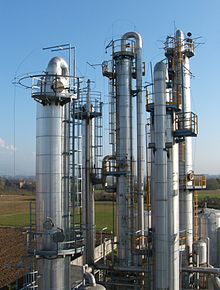
The scale of chemical manufacturing tends to be organized from largest in volume (
The petrochemical and commodity chemical manufacturing units are on the whole single product continuous processing plants. Not all petrochemical or commodity chemical materials are made in one single location, but groups of related materials often are to induce industrial symbiosis as well as material, energy and utility efficiency and other economies of scale.
Those chemicals made on the largest of scales are made in a few manufacturing locations around the world, for example in
Specialty chemical and fine chemical manufacturing are mostly made in discrete batch processes. These manufacturers are often found in similar locations but in many cases, they are to be found in multi-sector business parks.
Continents and countries
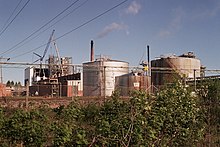
In the U.S. there are 170 major chemical companies.[18] They operate internationally with more than 2,800 facilities outside the U.S. and 1,700 foreign subsidiaries or affiliates operating. The U.S. chemical output is $750 billion a year. The U.S. industry records large trade surpluses and employs more than a million people in the United States alone. The chemical industry is also the second largest consumer of energy in manufacturing and spends over $5 billion annually on pollution abatement.
In Europe, the chemical, plastics, and rubber sectors are among the largest industrial sectors.[19] Together they generate about 3.2 million jobs in more than 60,000 companies. Since 2000 the chemical sector alone has represented 2/3 of the entire manufacturing trade surplus of the EU.
In 2012, the chemical sector accounted for 12% of the EU manufacturing industry's added value. Europe remains the world's biggest chemical trading region with 43% of the world's exports and 37% of the world's imports, although the latest data shows that Asia is catching up with 34% of the exports and 37% of imports.[20] Even so, Europe still has a trading surplus with all regions of the world except Japan and China where in 2011 there was a chemical trade balance. Europe's trade surplus with the rest of the world today amounts to 41.7 billion Euros.[21]
Over the 20 years between 1991 and 2011, the European Chemical industry saw its sales increase from 295 billion Euros to 539 billion Euros, a picture of constant growth. Despite this, the European industry's share of the world chemical market has fallen from 36% to 20%. This has resulted from the huge increase in production and sales in emerging markets like India and China.[22] The data suggest that 95% of this impact is from China alone. In 2012 the data from the European Chemical Industry Council shows that five European countries account for 71% of the EU's chemicals sales. These are Germany, France, the United Kingdom, Italy and the Netherlands.[23]
The chemical industry has seen growth in China, India, Korea, the Middle East, South East Asia, Nigeria and Brazil. The growth is driven by changes in feedstock availability and price, labor and energy costs, differential rates of economic growth and environmental pressures.
Just as companies emerge as the main producers of the chemical industry, we can also look on a more global scale at how industrialized countries rank, with regard to the billions of dollars worth of production a country or region could export. Though the business of chemistry is worldwide in scope, the bulk of the world's $3.7 trillion chemical output is accounted for by only a handful of industrialized nations. The United States alone produced $689 billion, 18.6 percent of the total world chemical output in 2008.[24]
| Global Chemical Shipments by Country/Region (billions of dollars)[24] | 1998 | 1999 | 2000 | 2001 | 2002 | 2003 | 2004 | 2005 | 2006 | 2008 | 2009 |
|---|---|---|---|---|---|---|---|---|---|---|---|
| United States of America | 416.7 | 420.3 | 449.2 | 438.4 | 462.5 | 487.7 | 540.9 | 610.9 | 657.7 | 664.1 | 689.3 |
| Canada | 21.1 | 21.8 | 25.0 | 24.8 | 25.8 | 30.5 | 36.2 | 40.2 | 43.7 | 45.4 | 47.4 |
| Mexico | 19.1 | 21.0 | 23.8 | 24.4 | 24.3 | 23.5 | 25.6 | 29.2 | 32.0 | 33.4 | 37.8 |
| North America | 456.9 | 463.1 | 498.0 | 487.6 | 512.6 | 541.7 | 602.7 | 680.3 | 733.4 | 742.8 | 774.6 |
| Brazil | 46.5 | 40.0 | 45.7 | 41.5 | 39.6 | 47.4 | 60.2 | 71.1 | 82.8 | 96.4 | 126.7 |
| Other | 59.2 | 58.1 | 60.8 | 63.4 | 58.6 | 62.9 | 69.9 | 77.2 | 84.6 | 89.5 | 102.1 |
| Latin America | 105.7 | 98.1 | 106.5 | 104.9 | 98.2 | 110.3 | 130.0 | 148.3 | 167.4 | 185.9 | 228.8 |
| Germany | 124.9 | 123.2 | 118.9 | 116.1 | 120.1 | 148.1 | 168.6 | 178.6 | 192.5 | 229.5 | 263.2 |
| France | 79.1 | 78.5 | 76.5 | 76.8 | 80.5 | 99.6 | 111.1 | 117.5 | 121.3 | 138.4 | 158.9 |
| United Kingdom | 70.3 | 70.1 | 66.8 | 66.4 | 69.9 | 77.3 | 91.3 | 95.2 | 107.8 | 118.2 | 123.4 |
| Italy | 63.9 | 64.6 | 59.5 | 58.6 | 64.5 | 75.8 | 86.6 | 89.8 | 95.3 | 105.9 | 122.9 |
| Spain | 31.0 | 30.8 | 30.8 | 31.9 | 33.4 | 42.0 | 48.9 | 52.7 | 56.7 | 63.7 | 74.8 |
| Netherlands | 29.7 | 29.4 | 31.3 | 30.6 | 32.2 | 40.1 | 49.0 | 52.7 | 59.2 | 67.9 | 81.7 |
| Belgium | 27.1 | 27.0 | 27.5 | 27.1 | 28.7 | 36.1 | 41.8 | 43.5 | 46.9 | 51.6 | 62.6 |
| Switzerland | 22.1 | 22.2 | 19.4 | 21.1 | 25.5 | 30.3 | 33.8 | 35.4 | 37.8 | 42.7 | 53.1 |
| Ireland | 16.9 | 20.1 | 22.6 | 22.9 | 29.1 | 32.3 | 33.9 | 34.9 | 37.5 | 46.0 | 54.8 |
| Sweden | 11.1 | 11.4 | 11.2 | 11.0 | 12.5 | 15.9 | 18.2 | 19.3 | 21.2 | 21.2 | 22.6 |
| Other | 27.1 | 26.8 | 25.9 | 26.4 | 27.9 | 33.5 | 38.6 | 42.9 | 46.2 | 50.3 | 58.9 |
| Western Europe | 503.1 | 504.0 | 490.4 | 488.8 | 524.4 | 630.9 | 721.9 | 762.7 | 822.4 | 935.4 | 1,076.8 |
| Russia | 23.8 | 24.6 | 27.4 | 29.1 | 30.3 | 33.4 | 37.5 | 40.9 | 53.1 | 63.0 | 77.6 |
| Other | 22.3 | 20.3 | 21.9 | 23.4 | 25.3 | 31.4 | 39.6 | 46.2 | 55.0 | 68.4 | 87.5 |
| Central/Eastern Europe | 46.1 | 44.9 | 49.3 | 52.5 | 55.6 | 64.8 | 77.1 | 87.1 | 108.0 | 131.3 | 165.1 |
| Africa & Middle East | 52.7 | 53.2 | 59.2 | 57.4 | 60.4 | 73.0 | 86.4 | 99.3 | 109.6 | 124.2 | 160.4 |
| Japan | 193.8 | 220.4 | 239.7 | 208.3 | 197.2 | 218.8 | 243.6 | 251.3 | 248.5 | 245.4 | 298.0 |
| Asia-Pacific excluding Japan | 215.2 | 241.9 | 276.1 | 271.5 | 300.5 | 369.1 | 463.9 | 567.5 | 668.8 | 795.5 | 993.2 |
| China | 80.9 | 87.8 | 103.6 | 111.0 | 126.5 | 159.9 | 205.0 | 269.0 | 331.4 | 406.4 | 549.4 |
| India | 30.7 | 35.3 | 35.3 | 32.5 | 33.5 | 40.8 | 53.3 | 63.6 | 72.5 | 91.1 | 98.2 |
| Australia | 11.3 | 12.1 | 11.2 | 10.8 | 11.3 | 14.9 | 17.0 | 18.7 | 19.1 | 22.8 | 27.1 |
| Korea | 39.3 | 45.5 | 56.3 | 50.4 | 54.9 | 64.4 | 78.7 | 91.9 | 103.4 | 116.7 | 133.2 |
| Singapore | 6.3 | 8.5 | 9.5 | 9.4 | 12.5 | 16.1 | 20.0 | 22.0 | 25.8 | 28.9 | 31.6 |
| Taiwan | 21.9 | 23.7 | 29.2 | 26.8 | 28.4 | 34.3 | 44.5 | 49.5 | 53.8 | 57.4 | 62.9 |
| Other Asia/Pacific | 24.8 | 29.1 | 30.9 | 30.8 | 33.3 | 38.8 | 45.5 | 52.9 | 62.9 | 72.2 | 90.8 |
| Asia/Pacific | 409.0 | 462.3 | 515.7 | 479.7 | 497.7 | 587.8 | 707.5 | 818.8 | 917.3 | 1041.0 | 1291.2 |
| Total world shipments | 1573.5 | 1625.5 | 1719.0 | 1670.9 | 1748.8 | 2008.5 | 2325.6 | 2596.4 | 2858.1 | 3160.7 | 3696.8 |
See also
- Chemical engineering
- Chemical leasing
- Pharmaceutical industry
- Industrial gas
- Prices of chemical elements
- Responsible Care
- Northeast of England Process Industry Cluster(NEPIC)
References
- ^ Derry, Thomas Kingston; Williams, Trevor I. (1993). A Short History of Technology: From the Earliest Times to A.D. 1900. New York: Dover.
- ^ Kiefer, David M. (2001). "Sulfuric Acid: Pumping Up the Volume". American Chemical Society. Retrieved 2008-04-21.
- ^ "The Chemical Industries In The UK". American Chemical Society. Retrieved 2013-04-21.
- ^ Aftalion 1991, pp. 11–13
- ^ a b Aftalion 1991, pp. 14–16
- S2CID 221115202.
- ^ Aftalion 1991, p. 104, Chandler 2005, p. 475
- ^ "Electrolytic Production of Bromine - National Historic Chemical Landmark - American Chemical Society". American Chemical Society. Retrieved 2016-10-10.
- ^ Patents for inventions. UK Patent office. 1857. p. 255.
- ^ Jeannifer Filly Sumayku (22 March 2010). "Unilever: Providing Enjoyable and Meaningful Life to Customers". The President Post. Archived from the original on 2013-12-15.
{{cite web}}: CS1 maint: unfit URL (link) - ^ ISBN 978-81-203-4617-8.
- ^ "Chemicals Market Size, Trends and Global Forecast To 2032". www.thebusinessresearchcompany.com. Retrieved 2023-08-04.
- ^ a b "Sectors of Chemical Industry". Technofunc. Retrieved 16 September 2013.
- ^ Global Specialty Chemicals (PDF) (Report). Marketline. May 2012. Archived from the original (PDF) on 15 November 2012. Retrieved 16 September 2012.
- ^ Global Speciality Chemicals (PDF) (Report). MarketLine. May 2012. Archived from the original (PDF) on 2012-11-15. Retrieved 2012-09-16.
- ^ Tullo, Alexander H. "C&EN's Global Top 50 | July 25, 2016 Issue - Vol. 94 Issue 30 | Chemical & Engineering News". cen.acs.org. Retrieved 2016-10-10.
- ^ "Chemical and Agrochemical Enterprise Quality Management Software". Sparta Systems, Inc. Archived from the original on 7 October 2015. Retrieved 20 March 2015.
- ISBN 978-81-203-4617-8.
- ^ "Our contribution to EU27 industry". cefic.org. Retrieved 28 October 2022.
- ^ "Facts and Figures 2012:The European chemicals industry in a worldwide perspective" (PDF). CEFIC. Archived from the original (PDF) on 4 March 2016. Retrieved 5 August 2013.
- ^ Higgins, Stan (April 2013). "European Chemicals Industry: A review" (PDF). Chemical News. pp. 18–20. Archived from the original (PDF) on 2015-07-23. Retrieved 2013-08-05.
- ^ "Facts and Figures 2012:The European chemicals industry in a worldwide perspective" (PDF). CEFIC. p. 6. Archived from the original (PDF) on 4 March 2016. Retrieved 5 August 2013.
- ^ "Facts and Figures 2012:The European chemicals industry in a worldwide perspective" (PDF). CEFIC. p. 7. Archived from the original (PDF) on 4 March 2016. Retrieved 5 August 2013.
- ^ a b "Global Business of Chemistry". Archived from the original on 2010-10-19. Retrieved 26 February 2016.
- Aftalion, Fred (1991). A History of the International Chemical Industry. University of Pennsylvania Press.
- Brandt, E. N. (1997). Growth Company: Dow Chemical's First Century. Michigan State University Press. ISBN 0-87013-426-4.. online review
- Chandler, Alfred D. (2005). Shaping the Industrial Century: The Remarkable Story of the Evolution of the Modern Chemical and Pharmaceutical Industries. Harvard University Press. ISBN 0-674-01720-X.. chapters 3-6 deal with DuPont, Dow Chemicals, Monsanto, American Cyanamid, Union Carbide, and Allied in US; and European chemical producers, Bayer, Farben, and ICI.
- McCoy, Micheal; et al. (July 10, 2006). "Facts & Figures of the Chemical Industry". Chemical & Engineering News. 84 (28): 35–72.
- Shreve, R. Norris; Brink, Joseph A. Jr. (1977). The Chemical Process Industries (4th ed.). New York: McGraw Hill.
- Woytinsky, W. S.; Woytinsky, E. S. (1953). World Population and Production Trends and Outlooks. pp. 1176–1205. Contains many tables and maps on the worldwide chemical industry in 1950.
External links
- Chemical refinery resources: ccc-group.com
